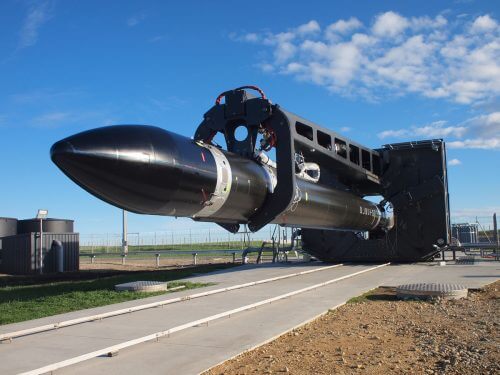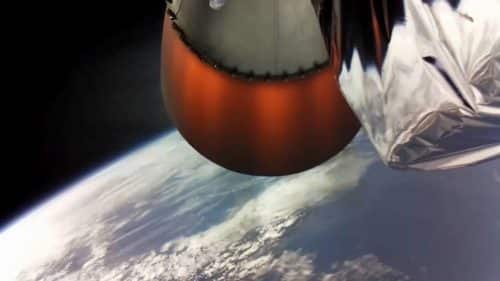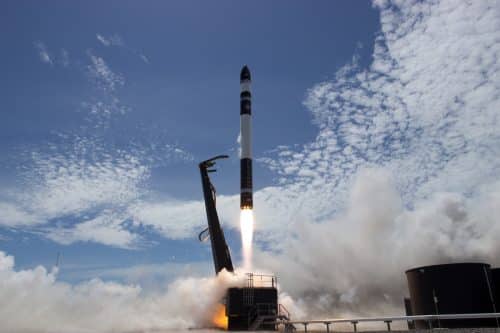The New Zealand-American "Rocket Love" company performed the first successful launch of the small "Electron" satellite launcher, which is capable of launching a payload weighing about 150 kg into a low-Earth orbit.
Watch the electron lift on Sunday:
Although it does not compare to giant launchers such as SpaceX's Falcon 9, which rises to a height of 70 meters, but with a size of 17 meters it is difficult to call it a "small" missile. Electron, manufactured by the New Zealand-American company Rocket Lab, is a new launcher that this week joined the limited club of active launch vehicles, with the goal of enabling a quick and cheap launch for the tiny satellite industry that began to flourish in the last decade.
Electron took off for its first successful flight on Sunday (January 21.1), 14:43 local time, from the Rocket Love company's private launch site on the Mahia Peninsula, on the North Island of New Zealand, according to Company announcement.
The takeoff began with the ignition of the nine rocket engines in the first stage of the launcher, which operated for two and a half minutes. After they were shut down, the first stage detached from the upper stage, whose single engine burned for five minutes. 8 minutes and 31 seconds after liftoff, the launcher released a payload of three cubesats into low Earth orbit.
The CubeSat satellites launched weigh only a few kilograms. Two of them were Spire's Lemur-2, which will join the array of tiny satellites the company is building, with the aim of making weather observations and tracking ships. The third tiny satellite is a Dove type from the Planet company, which builds an array of Earth observation satellites.

Sunday's successful launch, dubbed Still Testing, was Electron's second test flight, after its maiden flight in May 2017 failed to enter orbit. Rocket Love She said Because the launcher then operated properly and even managed to reach space, but a temporary malfunction in connection with the vehicle caused flight safety inspectors to have to stop the launch. The company planned to make the second test flight last December, but several last-minute cancellations due to problems with the vehicle or problematic weather conditions caused it to be postponed by a month.
"Getting to orbit with a second test flight is significant in itself, but successfully deploying customer payloads so early in the program [of developing] a new launcher is almost unprecedented," Rocket Love CEO Peter Beck, a New Zealander who founded the company in 2006, whose launch site is indeed in New Zealand, but its headquarters is located in Huntington Beach, California. "Rocket Love was established based on the principle of open access to space, in order to better understand our planet and provide our lives on it. Today we are happy to take a significant step towards that".
Rocket Love began developing the Electron launcher in 2012, with the aim of providing a quick and cheap launch for small payloads weighing about 150 kg, to a low-earth orbit at an altitude of 500 km. According to the company, the cost of launching one electron is estimated at about 5 million dollars, and when it enters full operational activity, it intends to launch more than 50 times a year.
The launcher is 17 meters high, 1.2 meters in diameter, and consists of two stages in its basic design, the first uses nine rocket engines of the type "Rutherford", and the second in a single Rutherford engine adapted to operate in the vacuum of space. The engines are named after the Nobel Prize-winning physicist born in New Zealand, Ernest Rutherford. The engine was built by Rocket Love using 24D printing, and according to the company, printing the components of one engine using this method only takes XNUMX hours.

The Rutherford engine, which burns RP-1 fuel (highly refined kerosene fuel) and liquid oxygen, is also unique in being the first in the world to use electric batteries to operate turbines responsible for injecting the fuel and liquid oxygen into the engine's combustion chamber. In standard rocket engines the turbines are activated by a complicated mechanism (the machine Gas-generator cycle) where part of the fuel is burned in a secondary combustion chamber, in order to create a hot gas that activates the turbines. According to the company, the operation of the turbines electrically, by lithium polymer batteries, increases the efficiency of the engine from 50% in the standard method to 95%.
Yesterday the company Unveiled Because during the flight we tested for the first time, and successfully, a new third rocket stage known as the "kick stage", which carried the two Lemur-2 satellites. After detaching from the second stage of the launcher, it continued cruising in an initial orbit at an altitude of 300 by 500 km, and after about 40 minutes activated an engine called "Kiri", which rounded the elliptical orbit to an orbit at an altitude of 490 by 500 km. The company did not provide technical details about the engine, but noted that it was also built with XNUMXD printing. According to her, the new phase will help provide more flexibility in the final orbits of the satellites that will be launched by Electron.
Electron belongs to a group of small launchers that are currently being developed, with the aim of meeting the needs of the thriving tiny satellite industry. Technological improvements in the last decade have allowed the development of tiny satellites the size of a shoe box and even smaller sizes, which satisfy the needs of research organizations and various companies. An example of this is the two companies that launched their satellites on top of the electron in its successful flight, which are developing a large array of such tiny satellites.
Among these new launchers we can mention two more whose development is in advanced stages, although they have not yet become active like an electron - Vector-R of Vector Space Systems, which will be able to launch about 60 kg into low-Earth orbit, andLauncher One of the Virgin Orbit company, which will be launched from a height of 10.6 under the wing of a 747 and will be able to carry up to 500 kg for a low-earth orbit.

Until now, tiny satellites have had to "catch a ride" alongside heavy satellites launched by large launch vehicles such as SpaceX's Falcon 9. Such large launchers can be adapted for the mass launch of tiny satellites, as happened last year, when the Indian PSLV launcher launched a record number of 104 tiny satellites at once (Two of them were Israelis - BGUSAT of Ben Gurion University and DIDO 2 of Spice Pharma). Even so, tiny satellites don't usually get priority like that of the main payload, which also includes flexibility in determining the altitude and inclination of the orbit they will be put into - and Electron and the other new launchers are designed to provide such priority for the booming tiny satellite industry.
Now, since Electron has completed its first successful flight, Rocket Love will be able to move forward to the stage of its business activity - when among the customers who have already signed a launch contract with it is Moon Express, one of the Google Lunar XPRIZE competitors for sending a private lander to the moon (yesterday, Tuesday, It was announced that the contest would end without a winner After it was made clear that none of the competing teams would meet the deadline of the end of March to complete the task).
